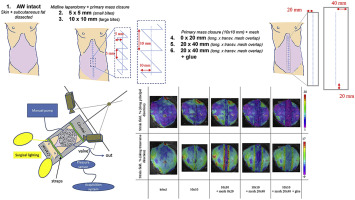Journal of the Mechanical Behavior of Biomedical Materials ( IF 3.3 ) Pub Date : 2020-02-07 , DOI: 10.1016/j.jmbbm.2020.103683 A Le Ruyet 1 , Y Yurtkap 2 , F P J den Hartog 2 , A Vegleur 1 , F Turquier 1 , J F Lange 2 , G J Kleinrensink 3

|
Introduction
Small bites for the closure of the abdominal wall after midline laparotomy result in significantly less incisional hernias in comparison with large bites. However, fundamental knowledge of underlying biomechanical phenomena remains sparse. The objective of this study was to develop a digital image correlation-based method to compare different suturing techniques in terms of strain pattern after closure of a midline laparotomy in a passive model just after the time of surgery.
Methods
A digital image correlation (DIC)-based method was used for the comparison of strain fields on the external surface of the myofascial abdominal wall (skin and subcutaneous fat removed) among six configurations, including an intact linea alba in five post mortem human specimens. The second configuration comprised primary mass closure with small bites (five mm between two consecutive stitches and five mm distance from the incision, 5x5 mm). The third configuration was primary mass closure with large bites (ten mm by ten mm, 10x10 mm). The fourth, fifth and sixth configuration comprised primary mass closure with large bites and the placement of a mesh in onlay position with two different overlaps and the use of glue to simulate the integration of the mesh within the soft tissue.
Results
No visible difference was observed between 5x5 and 10x10 mm closure configurations. However, the use of mesh as suture line reinforcement highlighted a stiffer behavior of the midline area for similar intra-abdominal pressure, which was amplified when a larger mesh overlap was used. However, the whole abdominal wall showed quite similar shapes for the various configurations, except for the configuration with mesh reinforcement and the use of glue.
Conclusion
Mesh reinforcement incited lower opening tension profiles in the midline area of the abdominal wall. following closure of the linea alba in median laparotomy. The next step should be to investigate the impact of mesh location (e.g. retromuscular) and different time points after surgery.
中文翻译:

有和没有网状增强的腹壁闭合生物力学的差异:对尸体人类标本的研究。
介绍
中线剖腹手术后小切口闭合腹壁导致切口疝较大切口减少。但是,有关潜在生物力学现象的基础知识仍然很少。这项研究的目的是开发一种基于数字图像相关性的方法,以比较手术后刚好在被动模型中线剖腹术闭合后在应变模式方面的不同缝合技术。
方法
基于数字图像相关性(DIC)的方法用于比较六种配置中肌筋膜腹壁外表面的应变场(去除了皮肤和皮下脂肪),包括五个死后人体标本中的完整白线。第二种配置包括初级咬合,咬合小(两个连续针距之间为5毫米,距切口5毫米,5x5毫米)。第三种配置是初级咬合,咬合较大(十毫米乘十毫米,10x10毫米)。第四,第五和第六配置包括具有大咬合的初级块闭合以及将网孔放置在具有两个不同重叠的重叠位置,以及使用胶水模拟网孔在软组织内的整合。
结果
在5x5和10x10 mm的封闭结构之间没有观察到明显的差异。但是,使用网眼作为缝合线加强件时,对于类似的腹腔内压力,中线区域表现出较硬的行为,当使用较大的网眼重叠时,这一点会放大。然而,除了具有网状加强结构和使用胶水的结构外,整个腹壁的各种形状都显示出非常相似的形状。
结论
网格加强引起腹壁中线区域较低的张开张力分布。在中腹剖腹术关闭了白线虫之后。下一步应该是研究网孔位置(例如,后肌)和手术后不同时间点的影响。











































 京公网安备 11010802027423号
京公网安备 11010802027423号